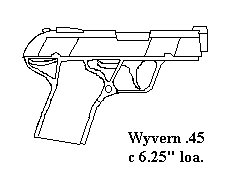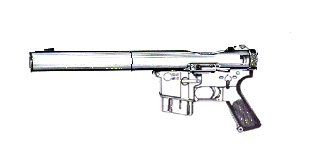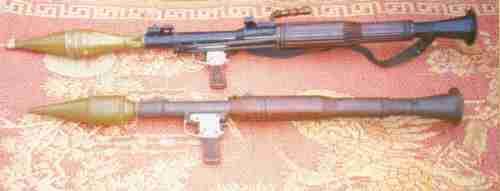
 Dragon .45 The Dragon is the standard duty wear handgun of West-force, and is noted for its accuracy, stopping power and reliability. It is capable of firing both .45ACP and .45 Super ammunition. Standard model has a double column magazine, but there are also narrower frames that take a single column mag and are suitable for smaller handed personnel or those that need a more concealable weapon. A long barrelled version of the Dragon is available for long range work and is favoured by mounted units as a saddle pistol.
Dragon .45 The Dragon is the standard duty wear handgun of West-force, and is noted for its accuracy, stopping power and reliability. It is capable of firing both .45ACP and .45 Super ammunition. Standard model has a double column magazine, but there are also narrower frames that take a single column mag and are suitable for smaller handed personnel or those that need a more concealable weapon. A long barrelled version of the Dragon is available for long range work and is favoured by mounted units as a saddle pistol.

 The SBIL is a single barrelled version of the MBIL and superficially resembles the RPG. It can be fitted with the MBIL sighting/ programming unit or can fire its rounds “ dumb” . As well as the 40mm rounds of the MBIL it is also used with overcalibre rounds including those designed for the RPG-7. The SBIL therefore has a lower rate of fire than the MBIL but more destructive and anti-tank capability.
The SBIL is a single barrelled version of the MBIL and superficially resembles the RPG. It can be fitted with the MBIL sighting/ programming unit or can fire its rounds “ dumb” . As well as the 40mm rounds of the MBIL it is also used with overcalibre rounds including those designed for the RPG-7. The SBIL therefore has a lower rate of fire than the MBIL but more destructive and anti-tank capability. A range of sighting systems, baseplates, bipods and two forms of barrels. The lightweight Commando barrel is 650mm long and is usually used as a platoon support weapon with only a small baseplate and no bipod. In this mode it has an effective range of around 1,200m. A sliding collar with two J shaped legs can be fitted, and is useful if it is desired to keep the weapon trained on a location. The barrel can also be fitted to the larger baseplate and bipod and fitted with more advanced sights. In this mode accurate fire can be made to more than 2,200m.
A range of sighting systems, baseplates, bipods and two forms of barrels. The lightweight Commando barrel is 650mm long and is usually used as a platoon support weapon with only a small baseplate and no bipod. In this mode it has an effective range of around 1,200m. A sliding collar with two J shaped legs can be fitted, and is useful if it is desired to keep the weapon trained on a location. The barrel can also be fitted to the larger baseplate and bipod and fitted with more advanced sights. In this mode accurate fire can be made to more than 2,200m.By the Author of the Scrapboard : | |
|---|---|
 | Attack, Avoid, Survive: Essential Principles of Self Defence Available in Handy A5 and US Trade Formats. |
 | |
 | Crash Combat Fourth Edition Epub edition Fourth Edition. |
 | |
 | |